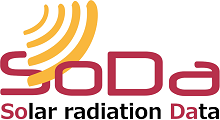Calibration
CALIBRATION service |
We provide on-demand long-term time series calibrated using short-term in-situ measurements. The long-term time series are extracted from our satellite-derived solar radiation database HelioClim-3. Note that we are also able to apply our calibration procedure on radiation data from any other provider. The short-term in-situ measurements are either provided by the Customer, or retrieved or bought from a nearest ground station. If the data are provided by the Customer, we agree to sign a Non Disclosure Agreement document to protect the confidentiality of your data. |
NB: Please also note that the computed calibration parameters can be used directly as an input parameter in the automatic access to HelioClim-3, so that you can directly receive recent or even real time calibrated HelioClim-3 time series. Please contact us for more details or to receive a quotation.
1. Quality check of the ground measurements
We apply a careful quality check procedure of the data, following the outcomes and recommendations of the European project ENDORSE. For more details on the quality check procedure, please refer to the ENDORSE report on the harmonization and control of meteorological data (D 3.2), and get a good summary in the poster Espinar et al. 2012.
The quality check procedure aims at identifying non plausible data and outlyers. A flag is provided with the returned data to inform with different degrees of plausibility. If the number of plausible data is insufficient, the calibration is not applied, and the Customer is informed by Transvalor that the calibration procedure is not possible with these data.
2. Assessment of the discrepancy prior calibration procedure
Once the quality of in-situ measurements has resulting in a sufficient number of plausible data, the discrepancy between satellite and in-situ measurements is assessed on the temporal period of the in-situ measurements. Several indices are computed to get a reference of the performance for the coming-next calibration.
3. Calibration procedure
The calibration procedure has been originally designed and validated during the Atlas PACA project. Afterwards, the procedure has been empirically fine-tuned to fulfill the requirements of the users. Two calibration methods are tested, and the best one is selected to provide the user with the best results:
- Method 1: uses a non-linear expression as a function of the Ktday and the decimal day of the year: aKt + b + cw2
- Method 2: computes regression parameters on intra-day values as a function of Kt and Gamma_sun
The result is a set of parameters estimated on the temporal period when the in-situ measurements are available, and then applied on the long-term satellite radiation values. The long term satellite-derived solar radiation HelioClim-3 version 5 dataset is provided to the user.
4. Assessment of the discrepancy after calibration procedure and data provision
The discrepancy is computed between the in-situ measurements and the calibrated satellite data on the temporal period of the in-situ measurements. The performance of the calibration procedure is given by comparing the discrepancy before and after the calibration procedure.
A report which describes and informs on the performance of the calibration procedure is provided together with the long term calibrated time series.
Publications
| Vernay et al. 2013 | Vernay C., Blanc P. and S. Pitaval, 2013. "Characterizing measurements campaigns for an innovative calibration approach of the global horizontal irradiation estimated by HelioClim-3", Renewable Energy, Vol., Sept. 2013, pp. 339–347. | Calibration efficiency |
Content: Calibration efficiency as a function of the duration and the beginning of the measurement campaign
| Vernay et al. 2012 | Vernay C., Pitaval S. and P. Blanc, 2012. "Calibration of long-term global horizontal irradiation estimated by HelioClim-3 through short-term local measurement campaigns: extending of the results to European and African sites" World Renewable Energy Forum, Denver, United States (2012) | Calibration efficiency |

